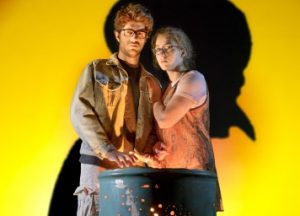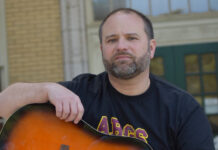
“How will we survive as a community?” asks the director’s notes of “Mr. Burns, a Post-Electric Play”. The answer: Storytelling.
Although it helps to have watched the episode of The Simpsons on which this play is based, it is certainly not necessary in order to enjoy the University Drama Department’s production of “Mr. Burns, a Post-Electric Play”, which premiered November 10 at the Ruth Caplin Theatre. This dark comedy explores the lasting legacy of pop culture in a post-apocalyptic world and the importance of storytelling as a ritualistic tool in order to ensure the survival of a sense of humanity.
Featuring a small but engaging cast, the first act of the play introduces the audience to a group of survivors of an unknown global catastrophe that is implied to be nuclear in origin. In between dismal discussion of lost family members and friends and fear of the unknown, the group lightens the mood with an animated re-telling of “Cape Feare,” an episode of The Simpsons that originally aired in 1993.
Ironically, the segment being retold from memory by the group is based on the 1991 Martin Scorsese film “Cape Fear,” which was itself a remake of a 1962 film that starred Robert Mitchum. With this knowledge in mind, “Mr. Burns, a Post-Electric Play” takes on an unsettling layered quality that is compounded by the desperation of the group to hold fast to cultural memories in an unrecognizable world.
Although the first act can seem disjointed in terms of the dialogue of the characters, which tells and retells excerpts from the Simpsons episode in an interrupted, not-always-chronologically-accurate fashion, the cast members generally handle the task with ease.
In the second act, the audience is transported seven years later to a group that has evolved in both the intensity and the production quality of their retellings. Now, the same characters make a living off live recreation of episodes of The Simpsons and buy lines from outside sources to be pieced together when their memory of the original plot fails them. These productions even include commercials that feature musical numbers cobbled together from pop songs of the ‘90s and early 2000’s, which the cast performs with thrilling energy.
The bizarre sense of order and structure portrayed by the new oral story culture is juxtaposed with the overall lawlessness and danger of society evident seven years after the apocalypse in this act, culminating in an unexpected shoot-out by the main cast and an unseen enemy.
With the third act of the play, the cast of “Mr. Burns” takes their production of The Simpsons episodes to new heights. In an all-musical extravaganza, seventy-five years after the apocalypse, the characters find themselves telling a far older, more primal story that brings the play full circle by weaving in fragments of the earlier “Cape Feare” episode as well as snatches of dialogue taken from conversations in the first act.
More than anything, the final act represents the culmination of the creation of a “good versus evil” narrative that serves to sustain the members of this post-apocalyptic community. Beyond the content itself, the act of performing a musical ceremony is essential to the survival of society’s sense of cultural history in this masterful production of “Mr. Burns, a Post-Electric Play”.
















